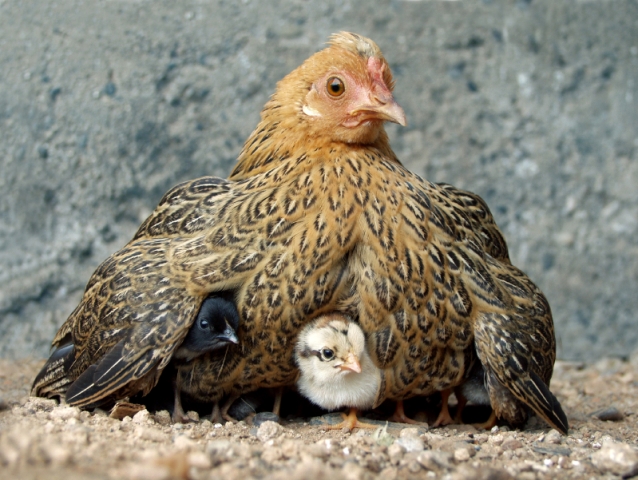 Findings by several
archeologists in the 1950s and ‘60s show that around 10,000 BCE--the beginning
of the Late Stone or Neolithic Age--people who rely on hunting and gathering
are reaping wild barley and wild wheat with knives, grinding the grain and
using storage pits. They live in the Fertile Crescent, a broad, hilly
region stretching from mainland Greece and Crete in the west over Turkey,
Syria, Iraq and Iran to the foothills of the Hindu Kush in Afghanistan and
north Pakistan.
Findings by several
archeologists in the 1950s and ‘60s show that around 10,000 BCE--the beginning
of the Late Stone or Neolithic Age--people who rely on hunting and gathering
are reaping wild barley and wild wheat with knives, grinding the grain and
using storage pits. They live in the Fertile Crescent, a broad, hilly
region stretching from mainland Greece and Crete in the west over Turkey,
Syria, Iraq and Iran to the foothills of the Hindu Kush in Afghanistan and
north Pakistan.
The agricultural revolution
The art of farming is thought
to have begun when people first make the observation that a common weed they’ve
collected for eating is growing where they previously spilled seed. Before
people know how to cultivate by seeding, they probably begin by setting out
roots, tubers and shoots. Because women used to be the gatherers in the earlier
economy, they are considered to be the inventors of agriculture and also its
first cultivators (until the plow was invented). We don't know when animals
were first domesticated, but it’s assumed to coincide with farming.
The shift from a
hunting-gathering to an agricultural economy occurs between what archeologists
call the ‘proto-Neolithic’ era (c 9500-7500 BCE)--a transitional stage between
food collecting and cultivation--and the ‘basal-Neolithic' era (c 7500-6500
BCE)--the stage when grain agriculture and stock-breeding are firmly
established. This period is probably the most transformative in the life of
humankind. In the course of a few thousand years the world undergoes material
and spiritual developments so important that even the revolutionary changes of
our own machine, nuclear and information age can’t compare with them.
The first main effect of the
new means of subsistence is that, as a rule, our ancestors have enough to eat
(often more than needed). This stimulates both sexuality and mind, permits them
to settle down in hamlets and villages and lead fairly stable, predictable lives. Another effect is a great increase in population. Whereas several square
miles are needed to feed a hunting tribe, only a few acres of land take care of
the needs of a farmer’s family. The earlier, more apprehensive existence is
exchanged for one of reasonable continuity and competent control over processes
once entirely subject to the caprices of nature.
The mother-goddess and the
sacred bull are the earliest spiritual expression of the farming culture; the
bull is venerated because he fertilizes the milk-cows and plows (=fertilizes)
the earth. In history’s first temples (c 4000-3500 BC in Mesopotamia, or Sumer)
the earth-goddess is symbolized by a cow and her fertilizing consort by the
moon-bull who dies and is resurrected.
The evolution of consciousness
Since I connect this drastic
change in living conditions with an awakened mind, I suggest it takes place at
the same time as our species makes its breakthrough into full conscious
awareness. Although many circumstances (such as climatic and other
environmental changes) play a part in the agricultural revolution, I don’t
think people could have invented farming without full insight into the natural
processes and the laws of causality--like being able to examine the present,
draw conclusions from the past and predict the future.
I’ve found no studies that pinpoint when evolution bestows us with the gift (some call it curse) of
consciousness. We still don‘t know exactly what it is nor where
to find it (though neuroscience is working hard at it), but many scholars
consider it a very late arrival on the scene. For most of our life as a species
we probably live, just like the animals, according to innate behavior patterns.
But after millions of years of slow but steady growth, a series of genetic
mutations bring a spectacular expansion of the neo-cortex. And then, with a
bang, comes the final upgrade that makes it possible for us to reach a
conscious comprehension of the world--the prerequisite I posit for the
malevolent matriarchy.
Paleontologist Stephen Jay Gould calls consciousness the greatest invention in the history of life, because it allows life to become aware of itself. By enabling us to see things objectively and in pairs of opposites, it adds an entirely new dimension to human existence. From a non-conceptual and essentially childlike way of seeing things, we now turn to an adult and highly discerning view; one that includes the ominous realization that we possess personal power.
It is now we make the groundbreaking discovery I see as the main motive for inventing the custom of ritual regicide. A discovery that puts an end to the Benevolent Matriarchy and marks the beginning of the Malevolent Matriarchy, the birthplace of the male inferiority complex. See next post.
I welcome feedback and would love for you to leave a comment. You can post a comment below this article or you can click on this article's headline. For the full blog click originofsexism.blogspot.com
Paleontologist Stephen Jay Gould calls consciousness the greatest invention in the history of life, because it allows life to become aware of itself. By enabling us to see things objectively and in pairs of opposites, it adds an entirely new dimension to human existence. From a non-conceptual and essentially childlike way of seeing things, we now turn to an adult and highly discerning view; one that includes the ominous realization that we possess personal power.
I welcome feedback and would love for you to leave a comment. You can post a comment below this article or you can click on this article's headline. For the full blog click originofsexism.blogspot.com










